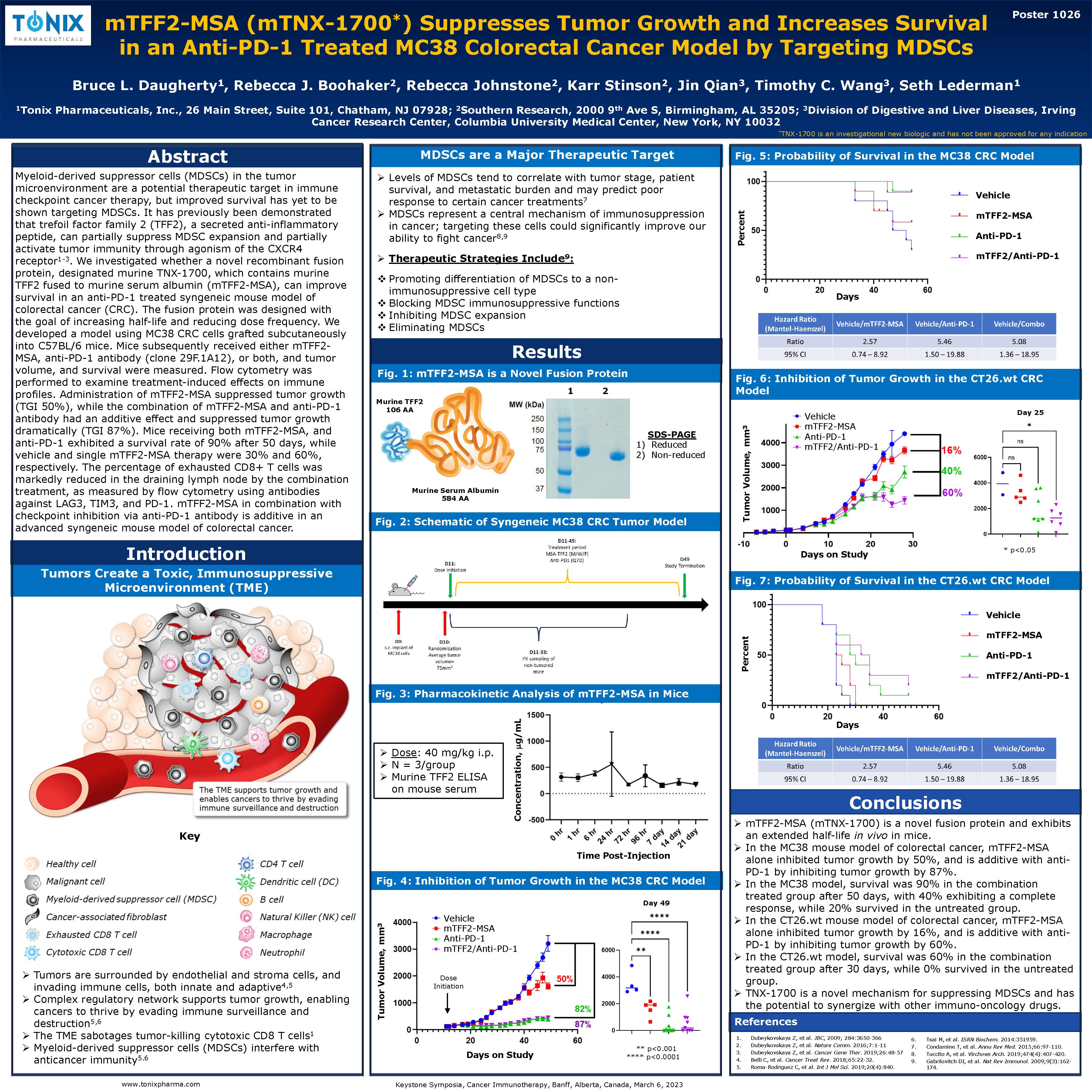
Tonix Pharmaceuticals Holding Corp. 8-K
Exhibit 99.02

mTFF2-MSA (mTNX-1700*) Suppresses Tumor Growth and Increases Survival in an Anti-PD-1 Treated MC38 Colorectal Cancer Model by Targeting MDSCsBruce L. Daugherty1, Rebecca J. Boohaker2, Rebecca Johnstone2, Karr Stinson2, Jin Qian3, Timothy C. Wang3, Seth Lederman11Tonix Pharmaceuticals, Inc., 26 Main Street, Suite 101, Chatham, NJ 07928; 2Southern Research, 2000 9thAve S, Birmingham, AL 35205; 3Division of Digestive and Liver Diseases, Irving Cancer Research Center, Columbia University Medical Center, New York, NY 10032 Abstract Tumors Create a Toxic, Immunosuppressive Microenvironment (TME) 1.DubeykovskayaZ, et al. JBC, 2009; 284:3650-366 2.DubeykovskayaZ, et al. Nature Comm. 2016;7:1-11 3.DubeykovskayaZ, et al. Cancer Gene Ther. 2019;26:48-57 4.Belli C, et al. Cancer Treat Rev.2018;65:22-32. 5.Roma-Rodriguez C, et al. Int J Mol Sci.2019;20(4):840. Conclusions References Key Tumors are surrounded by endothelial and stroma cells, and invading immune cells, both innate and adaptive4,5 Complex regulatory network supports tumor growth, enabling cancers to thrive by evading immune surveillance and destruction5,6 The TME sabotages tumor-killing cytotoxic CD8 T cells1 Myeloid-derived suppressor cells (MDSCs) interfere with anticancer immunity5.6 Levels of MDSCs tend to correlate with tumor stage, patient survival, and metastatic burden and may predict poor response to certain cancer treatments7 MDSCs represent a central mechanism of immunosuppression in cancer; targeting these cells could significantly improve our ability to fight cancer8,9 Therapeutic Strategies Include9: Promoting differentiation of MDSCs to a non-immunosuppressive cell type Blocking MDSC immunosuppressive functions Inhibiting MDSC expansion Eliminating MDSCs Results Fig. 1: mTFF2-MSA is a Novel Fusion Protein Murine TFF2 106 AA Introduction MDSCs are a Major Therapeutic Target Fig. 3: Pharmacokinetic Analysis of mTFF2-MSA in Mice Fig. 2: Schematic of Syngeneic MC38 CRC Tumor Model Time Post-Injection Fig. 6: Inhibition of Tumor Growth in the CT26.wt CRC Model Fig. 4: Inhibition of Tumor Growth in the MC38 CRC Model Fig. 7: Probability of Survival in the CT26.wt CRC Model Concentration, μg/mL Dose: 40 mg/kg i.p. N = 3/group Murine TFF2 ELISA on mouse serum 1 2 SDS-PAGE 1) Reduced 2) Non-reduced Murine Serum Albumin 584 AA mTFF2-MSA (mTNX-1700) is a novel fusion protein and exhibits an extended half-life invivoin mice. In the MC38 mouse model of colorectal cancer, mTFF2-MSA alone inhibited tumor growth by 50%, and is additive with anti-PD-1 by inhibiting tumor growth by 87%. In the MC38 model, survival was 90% in the combination treated group after 50 days, with 40% exhibiting a complete response, while 20% survived in the untreated group. In the CT26.wt mouse model of colorectal cancer, mTFF2-MSA alone inhibited tumor growth by 16%, and is additive with anti-PD-1 by inhibiting tumor growth by 60%. In the CT26.wt model, survival was 60% in the combination treated group after 30 days, while 0% survived in the untreated group. TNX-1700 is a novel mechanism for suppressing MDSCs and has the potential to synergize with other immuno-oncology drugs. Days Percent 6.Tsai M, et al. ISRN Biochem.2014:351959. 7.Condamine T, et al. AnnuRev Med.2015;66:97-110. 8.TuccitoA, et al. VirchowsArch. 2019;474(4):407-420. 9.GabrilovitchDI, et al. Nat Rev Immunol.2009;9(3):162-174. Poster 1026 Tumor Volume, mm3 Dose Initiation Days on Study ** p<0.001 **** p<0.0001 Day 49 Fig. 5: Probability of Survival in the MC38 CRC Model Days on Study Day 25 Days Percent Tumor Volume, mm3 * p<0.05 Keystone Symposia, Cancer Immunotherapy, Banff, Alberta, Canada, March 6, 2023 www.tonixpharma.com Myeloid-derived suppressor cells (MDSCs) in the tumor microenvironment are a potential therapeutic target in immune checkpoint cancer therapy, but improved survival has yet to be shown targeting MDSCs. It has previously been demonstrated that trefoil factor family 2 (TFF2), a secreted anti-inflammatory peptide, can partially suppress MDSC expansion and partially activate tumor immunity through agonism of the CXCR4 receptor1-3. We investigated whether a novel recombinant fusion protein, designated murine TNX-1700, which contains murine TFF2 fused to murine serum albumin (mTFF2-MSA), can improve survival in an anti-PD-1 treated syngeneic mouse model of colorectal cancer (CRC). The fusion protein was designed with the goal of increasing half-life and reducing dose frequency. We developed a model using MC38 CRC cells grafted subcutaneously into C57BL/6 mice. Mice subsequently received either mTFF2-MSA, anti-PD-1 antibody (clone 29F.1A12),or both, and tumor volume, and survival were measured. Flow cytometry was performed to examine treatment-induced effects on immune profiles. Administration of mTFF2-MSA suppressed tumor growth (TGI 50%), while the combination of mTFF2-MSA and anti-PD-1 antibody had an additive effect and suppressed tumor growth dramatically (TGI 87%). Mice receiving both mTFF2-MSA, and anti-PD-1 exhibited a survival rate of 90% after 50 days, while vehicle and single mTFF2-MSA therapy were 30% and 60%, respectively. The percentage of exhausted CD8+ T cells was markedly reduced in the draining lymph node by the combination treatment, as measured by flow cytometry using antibodies against LAG3, TIM3, and PD-1. mTFF2-MSA in combination with checkpoint inhibition via anti-PD-1 antibody is additive in an advanced syngeneic mouse model of colorectal cancer. Vehicle mTFF2-MSA Anti-PD-1 mTFF2/Anti-PD-1 Vehicle mTFF2-MSA Anti-PD-1 mTFF2/Anti-PD-1 Vehicle mTFF2-MSA Anti-PD-1 mTFF2/Anti-PD-1 Vehicle mTFF2-MSA Anti-PD-1 mTFF2/Anti-PD-1 *TNX-1700 is an investigational new biologic and has not been approved for any indication